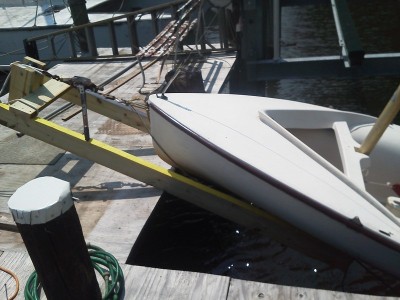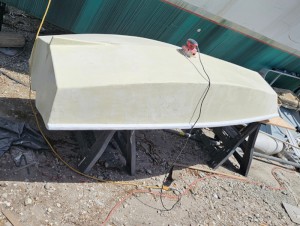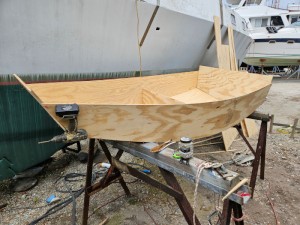Kaimusailing
s/v Kaimu Wharram Catamaran
| Vessel Name: | Kaimu |
| Vessel Make/Model: | Wharram Custom |
| Hailing Port: | Norwalk, CT |
| Crew: | Andy and the Kaimu Crew |
| About: | Sailors in the Baltimore, Annapolis, DC area. |
17 April 2024 | St Marys, GA
Dinghy Skeg
I was suffering with what seemed like a cold and also had allergy symptoms. I awoke and felt fine. The green pollen that was coating everything was gone. Maybe it will return.
07 April 2024 | St. Marys, GA
Clammy Hands
Items came in from TEMU, the Chinese cut rate retailer. One was a nice little drone that cost about twelve and a half dollars. It looked like an easy thing to play with while I coughed and sneezed. I was fighting a summer cold, even though it is not summer elsewhere, it seems like it here. A nice [...]
02 April 2024 | St. Marys, GA
Sun Doggie
After laminating the cedar strips onto the gunwales of the dinghy I found the screws I used wouldn’t come out. The epoxy had seized them. The screw heads were stripped so I cut a straight slot in the heads with the cut off wheel. The cedar smoked when the screw heads got red hot. I could remove [...]
21 March 2024 | St. Marys, GA
Just Add Water
The rainy weekend started off with overcast and fog but no rain. It looked like I might be able to get something done on the D4 dinghy. I wanted to change the bow seat which is really the bow deck. The sailing option uses the deck to hold the freestanding mast. I didn’t like how the deck looked, [...]
01 March 2024 | St. Marys, GA
D4 Dinghy Alternative Seats
The rain event was more wind than rain, strong winds with gusts up to 44 mph. We drove into town to see what the harbor was like. There was a small sailboat that had dragged anchor and was sitting close to shore. The tide was out. We left and played with Bleu at Notter’s Pond.
23 February 2024 | St. Marys, GA
D4 Inside Seams
Day two of the dinghy build started out with me finishing wiring the hull bottoms together on the centerline of the bottom panels. This was much easier than the wiring of the chine edges of the bottom panels and the side panels.
Down on the Dock

Captain Kris searched in his bilges and came up with some reinforced tubing of the correct size. The repair was completed with only a wrench and a tubing clamp lost to King Neptune. With running water now available on the dock, I proceeded to try out the water system in Kaimu's head. Hurray! the leaks have been fixed. Unfortunately the electrical lead on the hot water tap broke off. It would be nearly impossible to replace it now. "Fix it or Break it" became the motto of the day.
The problem with the Ulmer mainsail jamming in the sailing dinghy's mainsail slot was researched and it could be a damaged or dirty slot, or a need for lubrication of the sail's boltrope. I made a scotchbrite pad wrapped around a piece of line that would fit the slot and added a couple of grommets, one on top for the halyard to pull it up, and one on the bottom for the tail of the halyard to pull it down. Captain Neil saw the scotchbrite device and said it was available commercially. I replied that I had thought I had invented something.
Neil also showed me epoxy from http://www.advancedrepair.com/ and lent me some to work on Kaimu's deck table. This epoxy is remarkable because it retains its shape no matter what position. It doesn't sag. It can be used to recreate parts of deteriorated moldings, glue wood overhead, and many other uses.
I ran the scotchbrite soaked in Simple Green cleaner up and down the mast of the dinghy until I was sure it was clean. The Ulmer mainsail was inspected and I used a soldering gun to eliminate any loose fibers or cloth that might fold over and jam things. Finally I sprayed Loctite dry lubricant on the boltrope. When I tried to run this up the mast, it was smoother and easier, but an unexpected wrench fell into the works: the port shroud suddenly came loose, it had lost the pig ring holding the pin. Fortunately, or rather, amazingly, the pin was still there. The resultant calamity of trying to keep an unstayed mast in place in a little tippy dinghy ended up with abandonment of any repair, a bungy strap holding the mast, and a discouraged sailor closing up shop for the day. "Fix it or Break it".
We were experiencing another heat wave, so work would go unabated for about an hour or two, then it would be decided to take a break, maybe for the rest of the day. After a half hour in air conditioning, we could get back to tackle another task. Then the heat would be even hotter and take its toll quicker.
I repaired the port shroud of the dinghy with a new pig ring for the chain plate pin. The "new" 1983 mainsail was sprayed with dry lubricant on the headboard and luff boltrope and was possible now to pull it up, although with difficulty. The wind was from the West which meant from the head of the inlet, so I took the dinghy out and sailed up to the head of the inlet. The idea is to get upwind of the docks so that if worse comes to worst we can sail back downwind with more options of succeeding. If we started out sailing downwind and the wind increased, it would be impossible to bring the dinghy back to the dock against the wind.
The wind at the head of the inlet was fluky and after sailing all around, up and down, I brought it back relieved not to have dumped it. The water quality is not that good.
These hot days are best approached with an attitude of nibbling away at the projects. My work in the catamaran's head and water system in the port hull were not done, but could be wrapped up with chlorine shock of the water and hot water tanks, flush, and refill with some vinegar, flush again, but the heat below decks was debilitating, so instead, I took the forward part of the deck table apart and brought it up to the dockmaster's garage/workshop to make repairs.
I used the Advanced Repair epoxy form Captain Neil and it was sort of like regular epoxy with colloidal silica filler. The consistency was thinner than the vaseline consistency that I like, but it worked great for the deck table repair. It would fill gaps and cracks quickly and smoothly. I went on the Advanced Repair website and looked up this epoxy. The cost was right up there, but if you only used it for certain kind of repair, it would be worthwhile. It's like having colloidal silica filled epoxy with a simple 1:2 mix, no need to add the silica powder.
Another important discovery was that the automotive 2 part clear urethane I had used on the deck table worked fine, fine until it separated from the wood underneath. Then it became blisters and if they cracked, moisture under the blisters, and then beginnings of wood deterioration.
The little sailing dinghy was leaking, but pulling it out of the water could damage its hull, plus it might damage my elderly muscles. I made a dry sailing rack out of 2X6 pressure treated lumber. It was like a pair of rails with ballistic cloth stapled on, and then the boat could be pulled with a come-along up onto the rack and then both together all the way onto the dock.
The picture is of the dinghy being pulled up out of the water on the dry sailing rack.






